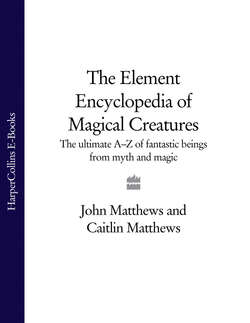Читать книгу The Element Encyclopedia of Magical Creatures: The Ultimate A–Z of Fantastic Beings from Myth and Magic - John Matthews - Страница 339
CENTAUR
ОглавлениеThe centaurs had the upper body of a man and the lower body of a horse. They were the offspring of Centaurus, a son of Apollo and Stilbe, one of the Mares of Magnesium. The cento part of their name means ‘to prick’, ‘to goad’ or ‘to wound’, and they were certainly known as wild, brutal and untameable creatures, all except the wise and gentle Cheiron; tauro refers to the ‘bull’, although centaurs were really half equine in nature and appearance. Centauros was the offspring of Ixion who visited Juno in the form of a cloud. But instead of giving birth to something divine, she bore ‘the most unblest of the Graces’. Centaurs frequented the mountains of Thessaly, where they retained an orgiastic, sensuous and unruly reputation, especially when they descended upon the wedding party of Lapiths, Greeks from the north of Thessaly, who had gathered to celebrate the marriage of Pirithous. ‘The Rape of the Lapiths’ showing centaurs killing, raping and overcoming the Lapiths was a famous subject depicted in many tapestries and paintings in later Renaissance times. Their passionate and untamed nature made them suitable associates for the Bacchic or Dionysian revels, and centaurs were depicted on tombs and funerary monuments as underworld guardians.
Xenophon called centaurs Hippocentaurs, because of their extremely horsy nature. The centaur with the bow and arrow remains the emblem of the zodiacal sign of Sagittarius. Some have seen similarities between centaurs and the Gandhavas, the cloud-horses of Vedic tradition. Christian iconography used centaurs to depict the
When Hercules was upon his fourth labour, he was welcomed by the centaur Pholos who was the guardian of a great jar, a gift intended for Hercules’ refreshment, which had been given by Dionysus. Pholos did not know that it was wine in the jar, having never tasted it. Once the jar was opened, all the centaurs from miles around were drawn by its intoxicating and alluring scent. The centaurs fell into a drinking bout, growing wilder and more intoxicated on the wine, becoming combative and dangerous. Hercules had to defend himself and so he drew out one of the arrows, poisoned by the blood of the Hydra. Aiming at an unruly centaur, Hercules accidentally struck gentle Cheiron. He tried in vain to save the wise centaur with healing herbs but Cheiron was pierced in the knee and could neither recover nor die, and so he retired with his incurable wound to his dark cave. He suffered for many years until he offered himself to Zeus as a substitute for the tormented Prometheus who had been sentenced to have his liver torn out daily for the sin of stealing fire from heaven. As Pholos was trying to pull out a poisoned arrow from a fellow’s corpse, the bolt pierced his foot and killed him too. Hercules buried Pholos and continued on his way to Mount Erymanthos.
devil aiming fiery arrows at the ungodly, attempting to stimulate man’s animal nature and rouse his passions to commit acts of lewd indecency and harbour heretical thoughts. But other theologians saw centaurs as symbols of Christ’s mortal sufferings who were allowed to take revenge upon those who had betrayed him to his death. In CS. Lewis’s Christian allegories, the Narnia books, such as The Lion, the Witch and the Wardobe, centaurs are part of the train of Aslan, the great lion king, the most notable of which, Glenstorm, acts as the herald of Prince Caspian in the book of the same name.
The magical powers of centaurs enable human beings to unlock repressed desires and thoughts. They unchain instinctual forces that have been imprisoned or denied, but you must never offer them wine unless you are prepared to take the consequences! (See Cheiron, Eurytion, Nessus, Pholos.)
